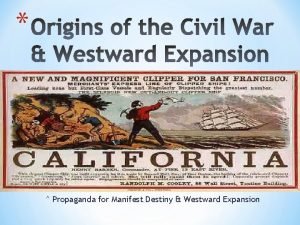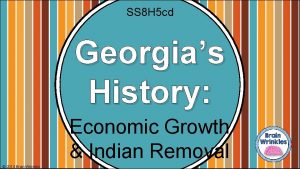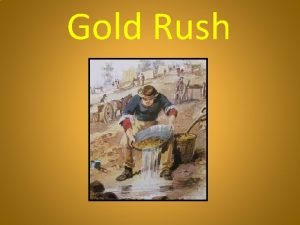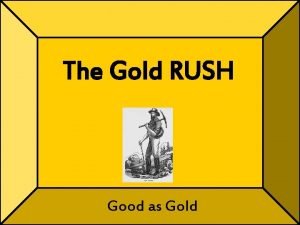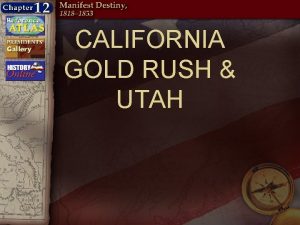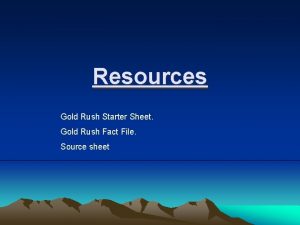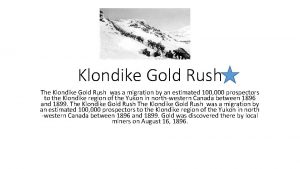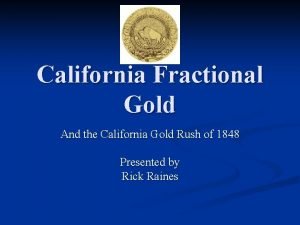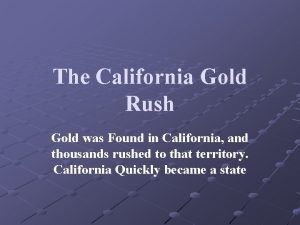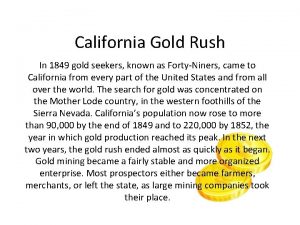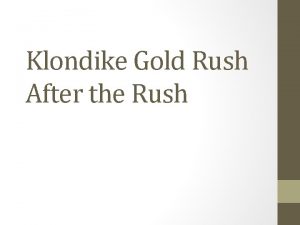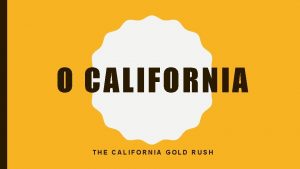The California Gold Rush CALIFORNIA GOLD RUSH Today













- Slides: 13

The California Gold Rush

CALIFORNIA GOLD RUSH Today we will learn how the Gold Rush affected people, towns and the state of California.

January 24, 1848 • The California gold rush began after gold was discovered at Sutter’s Mill in Coloma, near Sacramento • The discovery lead to one of the largest mass migrations in the world

The Miner • 98% of Forty-niners were men • “San Francisco was peopled by men alone! He who cannot make a bed, cook beefsteak, or sew up his own rips is unfit to be a citizen of California. ” “We resolved, out of respect for the pocket, to commerce the art of living without eating. ”

People and the Gold Rush “On every side stood buildings covered with signs in all languages… streets were full of Yankees, Californians in sombreros, Chileans, Hawaiians, Chinese and others impossible to recognize. ”

People and the Gold Rush • There were 150, 000 Native Americans, 6, 000 Californos, 800 Americans • Population increased to 300, 000 in 1852 • Chinese, Native Americans, Mexicans were heavily discriminated • Homelands were destroyed and diseases spread

People and the Gold Rush • Surface gold started running low, foreigners weren’t welcome • Miners from other countries had to pay a $20 tax every month; Foreign Miners Tax 1850 Law appealed 1851 • Native American Population decreased from 150, 000 to 30, 000 between 1845 -1870

Towns and the Gold Rush • Mining camps sprang up • San Francisco grew from 1, 000 people to 30, 000 by end of 1849 • Was largest city until 1920 • Sacramento grew to 12, 000 • Ships abandoned, and still being dug up today

End of the Rainbow • By 1852, miners had dug up over $81 million in gold • Only those who made enough money to buy big machinery would find gold • Gold Rush was over by 1858

Gold Rush and the Golden State • Cities, schools, churches and businesses were created • Sacramento became capital of the state • Transcontinental Railroad built by 1869 • State remains diverse The growing population lead to statehood, and California became 31 st state on September 9 th, 1850.

GOLD RUSH PROS CONS • Slaves bought freedom • Men didn’t always return home profitable or at all • Women supported • Thousands crossed families, men created oceans and deserts to businesses realize they should have • Some found fortune from stayed home rivers and streams • “Got home round by • “The first dust I received, $2, 800 made my eyes Panama… I was just sparkle…but now I weigh it $300 ahead on the 3 out with as little feeling as I years trip. Better would sand. ” stayed at home. ”


Towns and the Gold Rush • Most mining towns didn’t have formal laws • No police or jails • “Yesterday one American shot another in the street and the occurrence was noted as much as a dog fight at home. ”
 Westward expansion propaganda
Westward expansion propaganda The last gold rush belongs as much
The last gold rush belongs as much Georgia's cotton was shipped from the coastal city of
Georgia's cotton was shipped from the coastal city of When did the australian gold rush start
When did the australian gold rush start Who discovered the first gold
Who discovered the first gold Gold rush 250 000
Gold rush 250 000 Acrostic poem about life
Acrostic poem about life The last gold rush belongs as much
The last gold rush belongs as much Math help room purdue
Math help room purdue Atlantis conus abutments
Atlantis conus abutments Today's class will be at
Today's class will be at Meeting objective
Meeting objective Fingerprint ridge characteristics worksheet
Fingerprint ridge characteristics worksheet Today meeting or today's meeting
Today meeting or today's meeting
